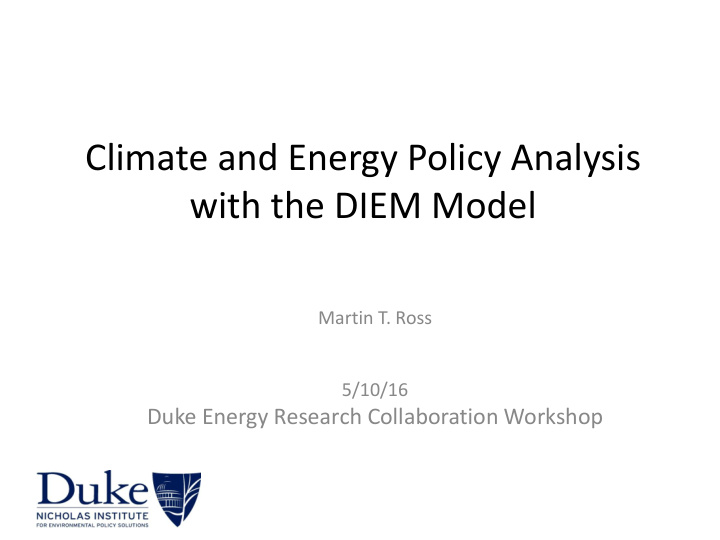



Climate and Energy Policy Analysis with the DIEM Model Martin T. Ross 5/10/16 Duke Energy Research Collaboration Workshop
DIEM Model – Macroeconomic Component “Dynamic Integrated Economy/Energy/Emissions Model” • Dynamic computable general equilibrium (CGE) model Economic & Energy Policies – Global and U.S. regional Economic & Trade Energy & GHG Electricity Generation – Energy production and consumption, six types GHG Global U.S. Regional – Non-energy industrial sectors GTAP Economic Data IMPLAN State Economic Data Trade IEA Energy Use & Prices EIA Energy Data Impacts EPA GHG Emissions EPA GHG Emissions – Household consumption International Trade Flows Detailed Households, etc. – Personal vehicle choices MODEL EQUATIONS – Advanced technologies Maximize Household Welfare DIEM-Electricity Firm Production Technologies Electricity supply – Current Applications: Stanford Demand & Supply of Goods Fuel consumption Energy Supply, Use, & Prices Factor demands GHG Emissions & Abatement Energy Modeling Forum (EMF) New generation Response to policy • Carbon taxes, revenue recycling, and income distribution impacts • Natural gas markets Output GDP & Welfare – Future Directions: Household Consumption Investment & Trade Flows • Paris agreement Energy Production by Type Energy Demand & Prices • Economic impacts of climate change GHG Emissions & Prices 2
Carbon Tax Recycling ($25/ton + 5%/year) (Hicksian equivalent variation from lowering the labor tax) East North South USA Northeast Central Southeast Central Central West All -0.24% -0.01% -0.19% -0.36% -0.37% -0.41% -0.13% <$10k -0.45% -0.34% -0.44% -0.48% -0.49% -0.56% -0.38% $10k-$15k -0.43% -0.25% -0.40% -0.48% -0.50% -0.56% -0.32% $15k-$20k -0.37% -0.15% -0.33% -0.44% -0.47% -0.51% -0.24% $20k-$30k -0.31% -0.08% -0.26% -0.40% -0.41% -0.46% -0.19% $30k-$40k -0.20% 0.05% -0.15% -0.31% -0.34% -0.37% -0.08% $40k-$50k -0.19% 0.05% -0.14% -0.31% -0.33% -0.36% -0.08% $50k-$70k -0.12% 0.11% -0.08% -0.26% -0.29% -0.31% -0.02% $70k-$100k -0.25% -0.06% -0.22% -0.38% -0.37% -0.43% -0.18% $100k-$150k -0.22% -0.02% -0.18% -0.36% -0.35% -0.40% -0.15% >$150k -0.06% 0.13% -0.02% -0.18% -0.20% -0.23% 0.01% Households by Annual Income Class and Region of the Country: Who pays/benefits from carbon taxes and can you buy political support? 3
DIEM Model – Electricity Dispatch Component “Dynamic Integrated Economy/Energy/Emissions Model” • Dynamic linear program model Minimize costs of generation subject to meeting demand and emissions policies – U.S. regional electricity markets (10-60 regions) – Data on existing / new units, forecasts of demand / fuel prices – Long-run investment, generation, and retirement decisions – Link to macroeconomic CGE – Application: EPA’s CPP • Choices of CO 2 emissions rate targets versus mass caps by states • Policy costs, changes in generation mix, reductions in criteria pollutants – Future Directions: • Health benefits of reductions • Long-term climate policies 4
Electricity Emissions in the U.S. EPA’s Clean Power Plan to reduce CO2 emissions by 30% below 2005 levels • Emissions rate targets with subcategorized coal and natural gas rates • Mass-based targets for existing units • Mass-based targets including new units 2,500 Low gas prices may result in similar emissions to the 2,250 Clean Power Plan Rate approach encourages MMTCO2 2,000 renewables and existing gas, but emissions can 1,750 grow over time Mass approach only 1,500 covering existing units can “leak” emissions into new units and grow over time 1,250 2015 2020 2025 2030 2035 2040 2045 2050 Mass approach covering new units provides 2005 emissions Baseline emissions certainty but Baseline w/EE Baseline w/EE & low Gas price may be more costly Rate (subcategorized) State choices matter a lot Mass (existing) Mass (new) 5
CPP Policy Costs (∆PV to 2040) (Change in capital, operating, fuel costs plus ERC/allowance trade value) 0.1% 0.1% -0.2% 4.4% 1.2% 0.1% 1.2% 0.1% -4.6% -1.3% 0.1% -0.1% -0.3% 2.1% 2.3% -0.5% 2.2% 0.0% 0.3% -0.7% 5.8% 0.0% -0.2% 2.8% -1.1% 1.4% 0.9% -0.8% -0.4% -2.6% -2.2% 0.6% -1.0% -0.2% 0.3% 0.1 0.0% States with Rate States with Mass RGGI 6
Estimated Health Benefits of Clean Power Plan* (Annual U.S. benefit = $18-$42 billion in 2030) Annual Benefits by County $0 - $1 million $1 - $5 million $5 - $25 million $25 - $50 million $50 - $500 million DIEM Model policy – CPP Mass cap with New units (New Source Complement) ( National: SO 2 reduction – 48%, NOx reduction – 30% ) Total present value of policy costs through 2040 – $12.1 billion * Author’s calculations based on the 7 EPA COBRA Screening Model (discount rate – 3%)
Thank You 8
Recommend
More recommend